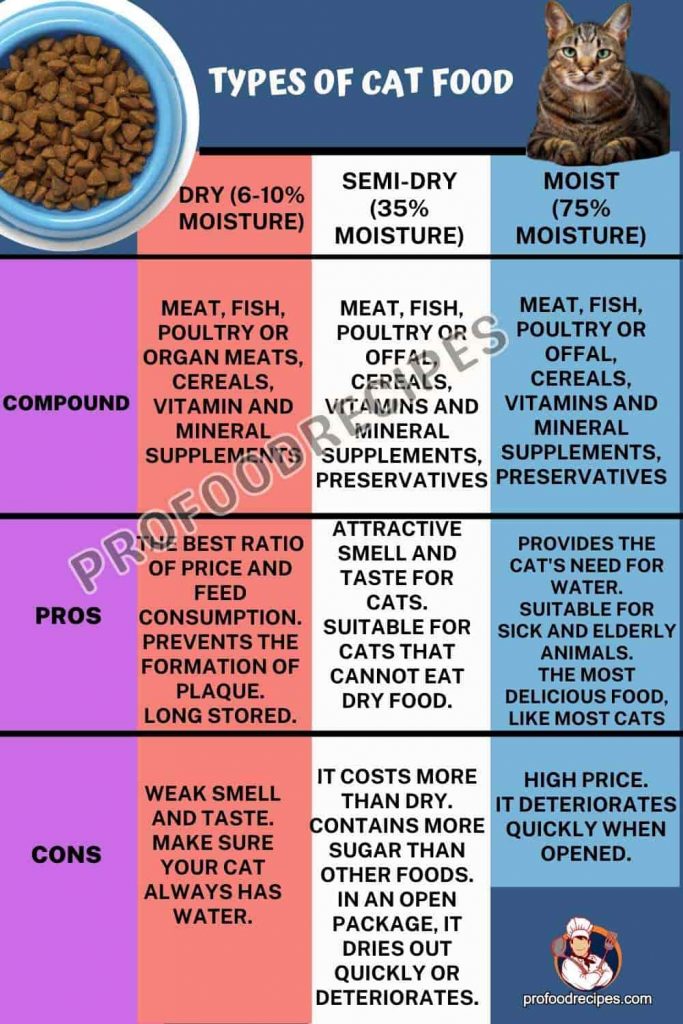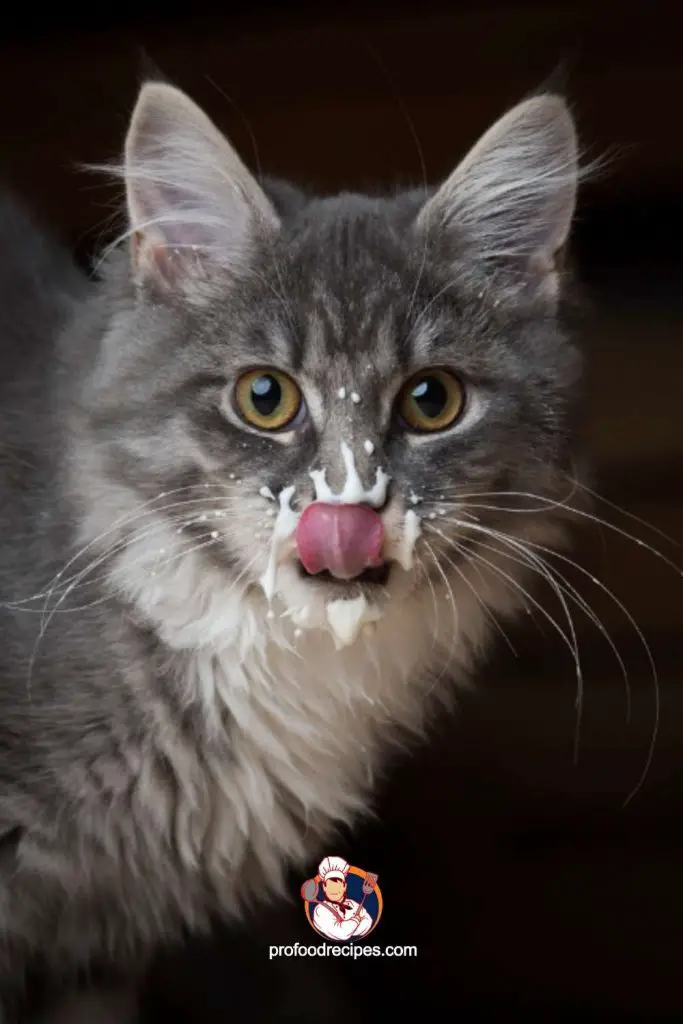Last Updated on July 20, 2022 by Amanda P. Brown
I talked to veterinarians about everything related to the cat’s diet. Today, I will tell you how to sort out many ready-made foods, choose between dry and wet, and even cook dinner for your pet with your own hands.
How to Choose Cat Food?
Table of Contents
The first step is to consult with a veterinarian. The specialist will take tests, examine the animal and make a suitable diet. It also applies when a cat refuses to eat the usual food – only a doctor can determine the cause and choose a new food.
What to Consider When Choosing Cat Food?
- The age of the animal – kittens need more high-calorie food, and aging cats need more fiber;
- Individual needs – free range of the animal, overweight, pregnancy;
- Pathologies – for example, with Urolithiasis and kidney failure, dietary food is needed.
Manufacturers suggest taking into account the breed of the cat. But, according to veterinarians, the features of the anatomy and physiology of the animal are important.
For example, Maine Coons need fatty acids to prevent joint diseases, but other large cats also need special food. And food for Persian cats with high fiber content can feed to long-haired animals with a similar muzzle structure.
An unbalanced diet is the main danger of choosing food without consulting a doctor. For example, animals that eat only meat may have low calcium levels. It causes tiredness, musculoskeletal difficulties, weight gain, and constipation.
What is Better -to Buy or Cook?
Experts say it all comes down to the pet’s nature and the owner’s capabilities. Both options have their pros and cons.
Industrial feeds are convenient – open the package and measure the right portion. But it is difficult to understand their composition fully – it is not always indicated on the packaging, and it is simply impossible to check the quality of the ingredients.
You can choose products for natural nutrition yourself, but here you need the skills of both a nutritionist and a cook.
Read More: Best Homemade Food for Persian Kitten
Types of Cat Food

Industrial feeds are divided into three types:
- Dry
- Semi-Dry
- Wet
1. Dry and Semi-Dry Food
It is most convenient for owners who feed their pets on a free schedule: if you pour “drying” into a bowl in the morning, it will remain fresh and tasty until the evening. It is also a suitable option for cases when you need to go away for 1-2 days and leave the cat alone. The main disadvantage of dry cat food is that it has no moisture. So the animal should always have fresh water in a bowl, automatic drinker, or drinking fountain.
Dry and semi-dry food should be stored in a hermetically sealed bag, follow the expiration date, and not be bought by weight – it is unknown how long they have been open.
2. Wet Food
Suitable for sick and recovering cats and old animals who find it challenging to chew crouton granules. This food has enough liquid, so the cats drink very little.
The main disadvantage is that spiders and canned food spoil quickly. If the cat does not eat a portion immediately, the product is winded and dries up in the evening after half an hour.
Therefore, leftover food is thrown away, and the unopened package is stored in the refrigerator tightly closed for no more than 2-3 days.
Another disadvantage of wet cat food is that it does not prevent plaque formation. Therefore, you must brush your cat’s teeth periodically if your cat eats canned food.
Read More: Dry Vs Wet Cat Food Pros and Cons
Careful, goodies!
When choosing wet food, check that it is suitable for daily feeding. Sometimes owners confuse it with a treat. For example, it can be pouches of gourmet preserves. And although they look the same, this is precisely a “dessert” and not a full meal.
Treats are needed to rekindle a sick or fussy cat’s interest in food or to pamper a cat if it is stressed by a move, a new pet, or a change of owners.

Can You Mix Dry and Canned Food?
Experts believe it is permissible to give a cat both “drying” and canned food at once. But it’s essential to ensure two things:
do not mix different types of food in one bowl;
- Choose food from one manufacturer.
- Products from different companies are mixed only to transfer a cat from one species to another.
Feed Classes
Industrial cat food is conventionally divided into three classes:
- Economy
- Premium and super-premium
- Holistic
The classification is based on the quantity and quality of products. The price also depends on the class.
1. Economy Class
This choice appears to be the least expensive at first. But these foods can cause health problems in animals due to the low protein content, high amounts of soy, artificial colors, and oxidizing agents. Sometimes they can even consist of bran alone. In addition, cheap food acts like fast food for people and is about the same as instant soups.
It turns out that the low price of economy feeds deceptive – after all, such food is likely to require the owner to spend money on a veterinarian and medicines. In addition, budget wet food is supposedly more expensive than premium dry food.
2. Premium Class
According to experts, this is the best-prepared food option that suits most animals. Nutritionists work on the composition and monitor not only the quality of the products but also the way they are prepared.
For example, in cheap canned food, there are few nutrients – they are partially destroyed during heat treatment. In expensive feeds, the possibility of such losses is considered in advance.
3. Holistic and Medicated Foods
Separately allocate food “holistic” or Human Grade. In them, all the ingredients are suitable for humans. It contains a lot of protein – fresh meat, easily digestible carbohydrates – potatoes, peas, lentils, fiber – vegetables, fruits, and berries. And also natural preservatives and high-quality vitamin and mineral supplements.
Veterinarians say such feeds are suitable for animals with an additional load – for example, they are free-range, pregnant, or sterilized.
But if your pet has kidney or liver problems, such a diet can aggravate the disease. In this case, you must select products from the medical line available from all major manufacturers.
Naturally, they are formulated considering the animal’s particular needs. Still, at the same time, they do not differ much in taste from ordinary food – therefore, the cat is easy to accustom.
How to Read Labels: What Should Be in the Feed
Typically, the ingredients on the label are ranked by weight. For example, in wet food, beef, fish, chicken, and turkey will be at the top of the list, while in dry food, they may be at the very bottom since excess moisture has been removed. Experts warn that the package may not contain complete information. If in doubt, it is better to consult a doctor or visit the manufacturer’s website and contact support.
1st Step
The first step is to look at the title and compare it to the lineup. It should consist of 35–95%, not counting water, of the product that is stated in the title. For example, if it is rabbit food, the main ingredient should be rabbit meat.
2nd Step
Checking every component on the list is the second step.
Cats are descendants of semi-desert predators, so they need a lot of protein, moderate fat, and a minimum of carbohydrates. And also – vitamins, minerals, fatty, and amino acids.
Therefore, check that the composition contains animal protein. Cats need taurine and omega-6 arachidonic acid, available only in animal and poultry flesh or offal. You cannot get these elements from plant foods, so vegetarianism is contraindicated for cats.
Read More: Vet Approved Homemade Cat Food Recipes
Useful and Harmful Components in Cat Food

Useful
- Protein (beef, chicken, turkey, rabbit) at least 35%.
- Fiber (oats, wheat, rice, and carbohydrates) is no more than 25%. Otherwise, the cat may have an upset stomach.
- Offal at least 30% of the composition.
- Vitamins and mineral supplements:
- Taurine, Omega-6 arachidonic acid, calcium, vitamin A, E, K, B vitamins, ascorbic acid, zinc, copper, and amino acids. Vitamin D is essential for kittens.
Read More: What Vegetables Are Best for Cats?
Harmful
- Dye E127 can provoke cancer.
- Oxidizers E320 and E321 can affect the liver and cause convulsions and neuroses.
- Waste includes skin, cartilage, feathers, horns, beaks, and hooves. If the packaging does not indicate a specific source of protein, the manufacturer may hide that the food is made from waste.
Veterinarians say that chicken feed should give to pets with caution. It is a potent allergen, although its effects don’t manifest themselves right away. Therefore, if the cat has an itch or the coat has faded, check the composition and consult a doctor.
Read More: What Vegetables Are Bad for Cats?
Are by-Products Useful?
Many owners avoid them because I think that wastes fall into this category – horns, hooves, skin, beaks. But by-products are internal organs, such as the liver, kidneys, lungs, and heart. They are healthy, nutritious, and easily absorbed by the cat’s body. Therefore, the food packaging should list the specific by-products included in the food.
Natural Feed: We Make the Menu Ourselves
Several essential recommendations exist for those who decide to feed the cat with natural food.
- Do not try to repeat the menu from the wild. You do not need to get rodents and birds for your pet.
- Do not give raw meat. It may contain parasites. For the meat to be safe, a scald of hot water or three days in the freezer.
- Do not feed the animal from your table. Most human food is contraindicated for cats. For a pet, you need to prepare special food or order frozen mixtures from natural products in pet stores on the Internet.
What’s Wrong With Fish and Milk?
Cat eats fish and milk in books and cartoons. In real life, milk and dairy products cause diarrhea in most pets. Animals, like people, lose the ability to digest milk with age – the body gradually ceases to produce enzymes that break down lactose.
When it comes to fish, cat owners are divided into two camps. Opponents believe that raw fish provokes the development of Urolithiasis. However, veterinarians say that they have not seen scientific studies that would confirm this fact.
But the real threat is still there – intestinal parasites. Scalding and freezing fish does not permanently destroy the worms. Therefore, if you want to feed fish to your cat 1-2 times a week, you should boil it or give the cat anthelmintic drugs once every three months.
Can I Mix Industrial and Natural Food?
Veterinarians recommend choosing one type of feeding and following it. For example, if you give your cat premium food, then an extra piece of natural meat will upset the balance of the diet. So don’t mix.
But you can offer your pet vegetables in addition to canned food. In addition, if some animal protein is replaced with vegetable protein in the finished food, a little chicken breast or beef will not hurt.
How to Know What Food is Suitable for Your Cat?
Veterinarians say that the food is balanced and suitable for your pet if he has:
- Shiny, smooth coat – no itching, irritation, unpleasant odor;
- no discharge from the eyes;
- Normal physique – no exhaustion and obesity;
- Shaped feces once a day, in an amount less than the incoming food;
- Normal activity.
Final Verdict
Owners often try to diversify the cat’s diet, offering them to try something new. But animals don’t need a new menu every day. The quality and method of feeding are the most critical factors for them. Therefore, it is necessary to transfer a pet from one food to another only when something does not suit you in his condition or behavior.
The transition from one producer to another takes about 3-5 days – for this, you need to gradually mix in more and more new food into the old food. Changing the type of feeding – from wet to dry or industrial to natural – will require 10-days or more.
You May Also Like to Read:
